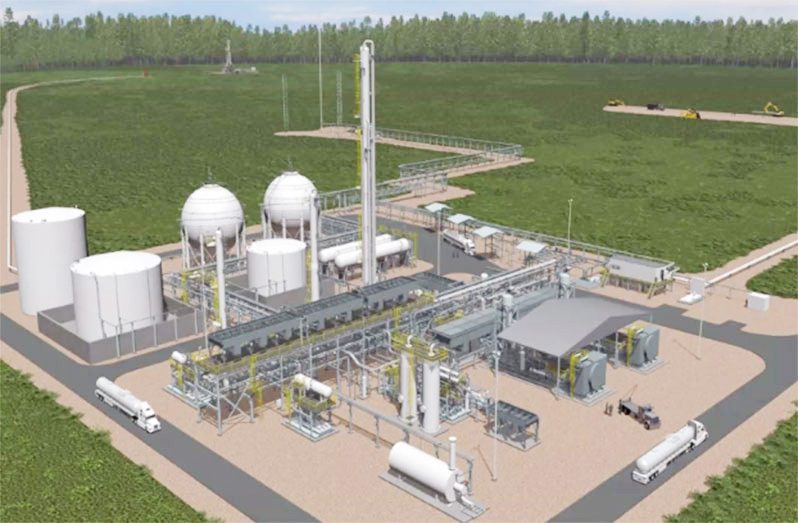GOVERNMENT has allocated $43.3 billion in the 2023 Budget to advance the construction of a power plant and natural gas liquids (NGL) facility, which is part of the much anticipated Wales gas-to-energy project.
This allocation will add to the $24.6 billion that was expended in 2022 to meet start-up costs associated with the project which is part of the government’s manifesto promise to provide more than 250MW of electricity from natural gas.
As such the government signed a contract for construction for an integrated NGL facility and power plant which will provide 300MW to the national grid.
“This represents the single largest investment made in the electricity sector, and single largest engineering, procurement and construction project ever undertaken. The project will cut emissions by 70 per cent and trigger a series of major economic development initiatives in Guyana. Energy cost will significantly decrease,” Senior Minister with responsibility for Finance, Dr. Ashni Singh explained, as he spoke on the energy sector during his budget speech on Monday.
In November, Cabinet gave its ‘no objection’ to the US-based partnership, CH4/Lindsayca for the construction of the 300-megawatt gas-to-energy plant. Some nine firms had prequalified to bid on the Engineering, Procurement, and Construction (EPC) contract and a Request for Proposals (RFP) was issued to the prequalified bidders. By the September 13 closing date, some five bids were received with CH4/Lindsayca emerging as the number one.
A 12-inch pipeline, which will stretch some 200km from offshore, will be used to transport natural gas from the Liza Phase One and Liza Phase Two Floating, Production, Storage, and Offloading (FPSO) vessels offshore, to the power plant and Natural Gas Liquids (NGL) facility.
Esso Exploration and Production Guyana Limited (EEPGL), which is owned by Exxon Mobil Guyana and partners Hess and CNOOC, has guaranteed the government that a minimum of 50 million standard cubic feet of gas per day (mmscfd) will be transported through the pipeline by 2024. The pipeline, which is expected to cost US$1 billion, will have a maximum capacity of 130 mmscfd.
The conversion of natural gas from ExxonMobil’s offshore operations to electricity is a key component of the People’s Progressive Party/Civic (PPP/C) Government’s objective to lower energy costs by at least 50 per cent through an energy mix which incorporates gas, solar, wind, and hydro power.
The energy matrix being crafted by the government is geared at looking well beyond the country’s current energy needs, but is also focused on catering for well forecasted future demand.
“Most importantly our energy mix is a careful study that addresses immediate short term intervention and the transformational needs of long term needs,” Dr. Singh said.
In the development of hydropower, the Amaila Falls Hydropower station (AFHP) is another transformational, highly anticipated project. During his budget speech, Dr. Singh noted that the government is expected to re-launch the request of proposals for the Amaila Falls project with the view of restarting it and ultimately realising it.
Though the government had initially awarded a contract to the China Railway Group Limited to construct the AFHP based on a Build-Own-Operate-Transfer (BOOT) model, the company later requested to change the BOOT contract arrangement to an EPC contract. However, the government did not agree to this, maintaining that it is holding the company to the BOOT bid they submitted.
When realised, the AFHP will lower the cost of electricity needed to power Guyana’s economic diversification and transformation into a low-carbon economy, as well as reduce the cost of power to the businesses and households.
According to Dr. Singh, strides being made in the country are being constrained by lack of reliable and environmentally sustainable energy, coupled by an aged and ailing power supply system.
The inability of Guyana Power and Light (GPL) to meet the present needs of the country’s power generation and distribution have affected and constrained industrial and business activity in Guyana.
“GPL is examining options for boosting short term generation needs,” Dr. Singh said.
Improvements on the cards for GPL include the replacement of 320 inefficient transformers in 2023, the acquisition of an additional 50MW of generating capacity, 413KM of new distribution lines, a new 69KV transmission line from Kingston to Sophia and from Edingburg to Mahaicony, as well as new and innovative substations at Hydronie, Sophia, and No. 53 Village, among other places.














